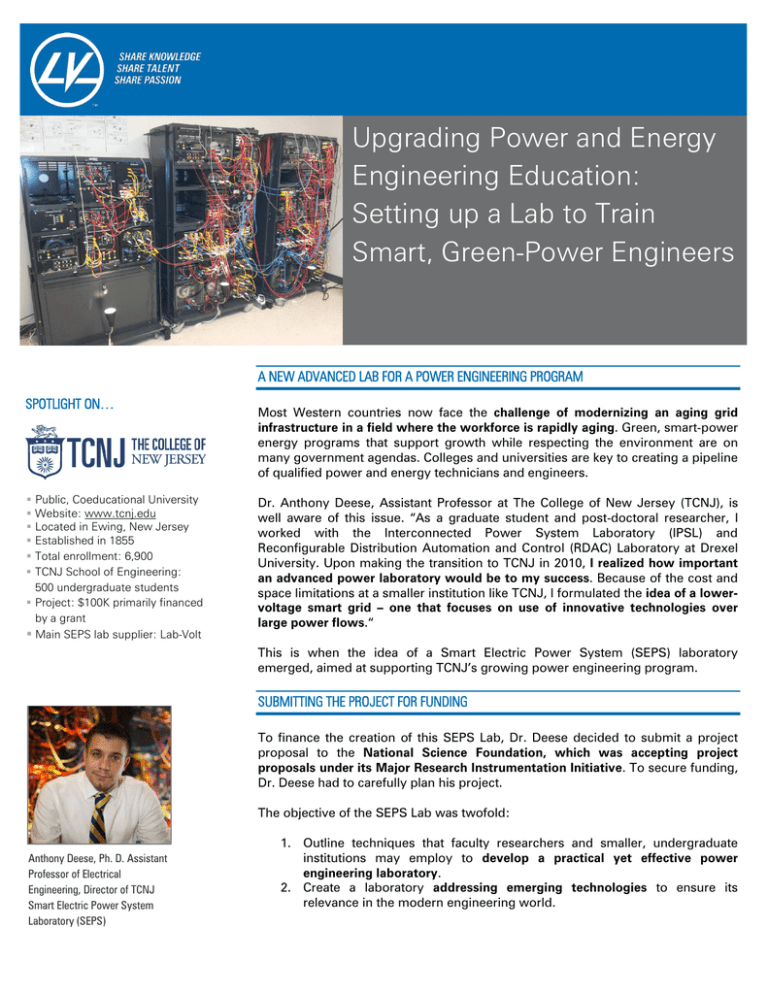
Upgrading Power and Energy
Engineering Education:
Setting up a Lab to Train
Smart, Green-Power Engineers
A NEW ADVANCED LAB FOR A POWER ENGINEERING PROGRAM
SPOTLIGHT ON…
Public, Coeducational University
Website: www.tcnj.edu
Located in Ewing, New Jersey
Established in 1855
Total enrollment: 6,900
TCNJ School of Engineering:
500 undergraduate students
Project: $100K primarily financed
by a grant
Main SEPS lab supplier: Lab-Volt
Most Western countries now face the challenge of modernizing an aging grid
infrastructure in a field where the workforce is rapidly aging. Green, smart-power
energy programs that support growth while respecting the environment are on
many government agendas. Colleges and universities are key to creating a pipeline
of qualified power and energy technicians and engineers.
Dr. Anthony Deese, Assistant Professor at The College of New Jersey (TCNJ), is
well aware of this issue. “As a graduate student and post-doctoral researcher, I
worked with the Interconnected Power System Laboratory (IPSL) and
Reconfigurable Distribution Automation and Control (RDAC) Laboratory at Drexel
University. Upon making the transition to TCNJ in 2010, I realized how important
an advanced power laboratory would be to my success. Because of the cost and
space limitations at a smaller institution like TCNJ, I formulated the idea of a lowervoltage smart grid – one that focuses on use of innovative technologies over
large power flows.“
This is when the idea of a Smart Electric Power System (SEPS) laboratory
emerged, aimed at supporting TCNJ’s growing power engineering program.
SUBMITTING THE PROJECT FOR FUNDING
To finance the creation of this SEPS Lab, Dr. Deese decided to submit a project
proposal to the National Science Foundation, which was accepting project
proposals under its Major Research Instrumentation Initiative. To secure funding,
Dr. Deese had to carefully plan his project.
The objective of the SEPS Lab was twofold:
Anthony Deese, Ph. D. Assistant
Professor of Electrical
Engineering, Director of TCNJ
Smart Electric Power System
Laboratory (SEPS)
1. Outline techniques that faculty researchers and smaller, undergraduate
institutions may employ to develop a practical yet effective power
engineering laboratory.
2. Create a laboratory addressing emerging technologies to ensure its
relevance in the modern engineering world.
WHICH TECHNOLOGIES MUST A SEPS LAB INCLUDE?
To ensure the SEPS Lab met the second part of its objective, Dr. Deese listed the
technologies that had to be included:
•
Remote Measurement and Control – One primary characteristic of a smart
grid is the presence of digital technology to facilitate remote measurement,
communication, and control of power system components.
•
Power Electronic Converters – The presence of power electronics in
transmission and distribution systems has grown drastically, primarily due
to reduced cost.
•
Direct Current Transmission – Europe’s power grid contains almost 30
high-voltage direct-current transmission links. The technology becomes
increasingly popular with that of power electronics.
•
Renewable Power Generation – Generation of electricity from renewable
energy sources is one of today’s most relevant engineering topics.
•
Grid-Connected Energy Storage – The utilization of bulk energy storage in
electric power systems is limited, predominantly because of high cost.
However, this technology has the greatest potential to revolutionize how
electricity is generated, transmitted, and consumed.
THE THREE DESIGN PRINCIPLES
The success of the project relied on the following design principles:
Configuration of Smart Electric Power
System (SEPS) Laboratory, Armstrong Hall,
TCNJ, in September 2012.
•
Robust and versatile: The laboratories of undergraduate institutions must
be facilitate the study of introductory as well as advanced topics, and be
versatile enough to be operated by novice as well as experienced
engineers.
•
Cost/Space efficient: Smaller institutions are often most sensitive to
funding and space limitations; the laboratories must provide significant
research and teaching benefits with conservative requirements.
•
Commercially-available: The construction and testing of custom hardware
requires time and effort; faculty researchers can turn to vendors to benefit
from their expertise and support.
Having previously worked with Lab-Volt’s training systems during his studies, Dr.
Deese knew that the quality, flexibility, and wide range of solutions would fit his
needs. He contacted Educational Solutions Enterprises, a partner in Lab-Volt’s sales
network.
To create the lab layout and select the right equipment, Dr. Deese teamed up with
Lab-Volt engineers. Together they created a powerful, customized lab that
answered all of Dr. Deese’s requirements by combining various modules and
components from existing power energy training systems to recreate the behavior
of an actual grid. This setup is also reconfigurable, i.e., all the components can be
rearranged for further experiments as the connections are not fixed.
What’s in the SEPS Lab?
The project was submitted and ultimately approved by the National Science
Foundation. The equipment was then purchased and installed on TCNJ premises
in September 2012. The following figure illustrates the final schematics of the lab:
The comprehensive lab equipment is based on
Lab-Volt’s Electric Power Technology Training
Program (Series 8010). LVDAC-EMS software
supports monitoring and control. See Lab-Volt’s
offering for Smart Grid (PDF) for more details.
Emerging smart grid technologies encompass
photovoltaic cells, wind turbines, battery
storage,
power
electronic
converters,
transmission lines management, remote control
of the grid, generators, automatic control, and
embedded data acquisition/control capability.
If you need help designing a custom lab project,
contact our team.
SEPS Lab – Nominal Configuration (Click to Enlarge)
A ONE-OF-A-KIND LAB FOR STUDENTS AND RESEARCHERS
During its first year of use, the SEPS lab was mainly used for the Power Systems
and Renewability course. It is now an essential part of the learning process, as
nothing can replace hands-on learning. It lets researchers manipulate the
parameters and topology of a power system and observe the effects of their
actions, thus enabling them to do innovative work aimed at addressing the
growing global need for smart energy conversion, distribution, and utilization.
“The lab has exceeded my expectations. I am proud of the fact that it is ‘one of a
kind,’ one type of advanced power laboratory that even larger institutions do not
have access to”, says Dr. Deese.
The SEPS Lab also increases TCNJ influence. ”Many large ECE programs in the
United States support advanced power engineering laboratory facilities, facilitating
innovative energy research and student understanding. The SEPS Laboratory allows
TCNJ faculty, students, and researchers to capably work alongside colleagues from
larger institutions.”
Labvolt.com|1-800-LAB-VOLT
For more information about the SEPS Lab,
visit www.anthonydeese.com or watch a
video presentation.
© Lab-Volt Systems, Inc. 2014. All rights reserved. This article was written thanks to the input of Mr. Anthony Deese, Ph. D. Assistant Professor of
Electrical Engineering, and Director of TCNJ Smart Electric Power System Laboratory (SEPS).





